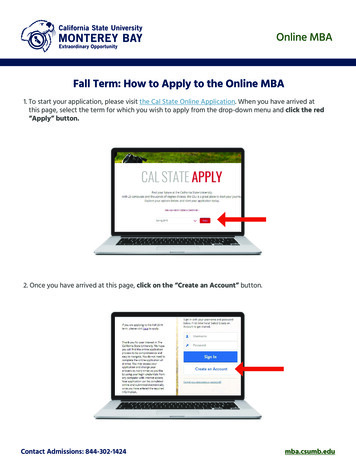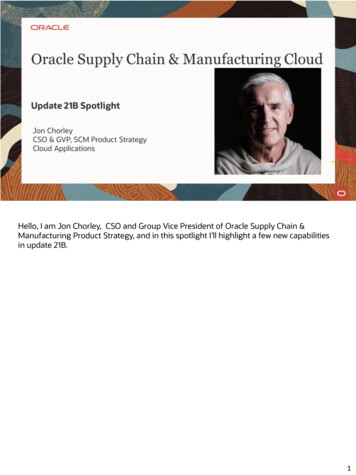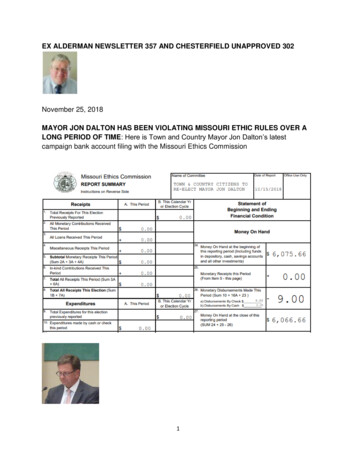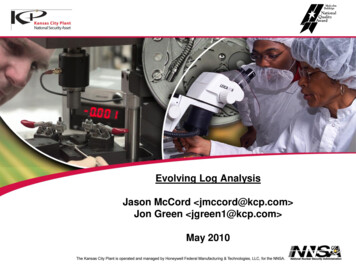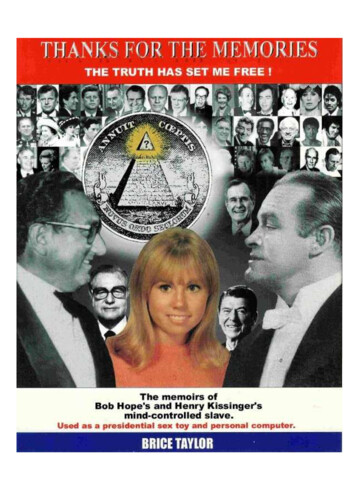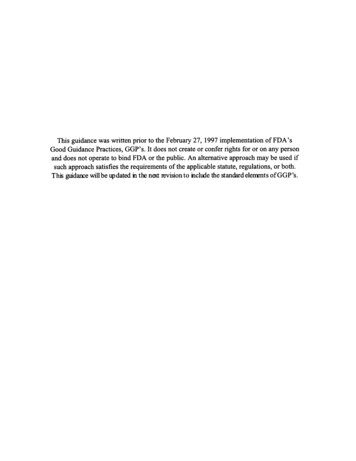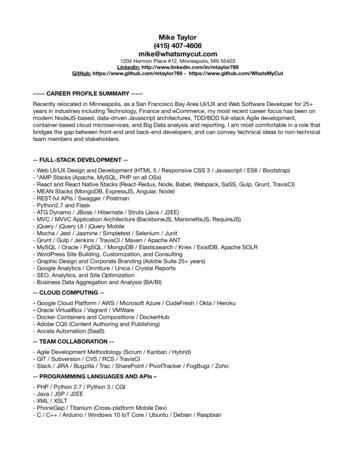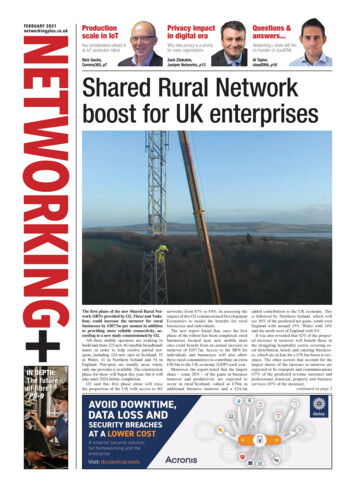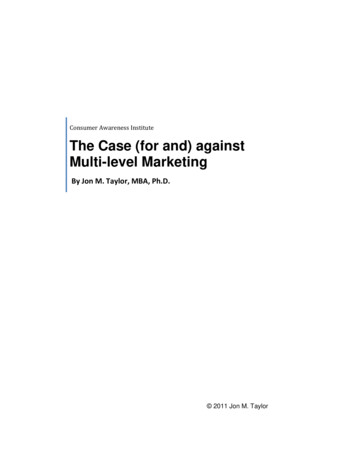
Transcription
Consumer Awareness InstituteThe Case (for and) againstMulti-level MarketingBy Jon M. Taylor, MBA, Ph.D. 2011 Jon M. Taylor
Intro-2The Case (for and) against Multi-level MarketingBy Jon M. Taylor, MBA, Ph.D.INTRODUCTION: purpose and plan for the bookContentsThe Amway precedent.A much needed resource.The many questions to be answeredin the bookMLM is an unfair and deceptive practiceSample MLM deceptionsThe title and logical bias for the bookPlan for the book1123356This book is intended to meet the needfor a thorough analysis of the businessmodel called multi-level marketing (MLM –a.k.a. “network marketing”) and itsembodiment in the emergence of thousandsof MLM programs (MLMs). Worldwide,thousands of consumers are approacheddaily with promises of income andindependence from joining one of these MLMs.open mind will understand why I and otherconsumer advocates lament the Amway ruling- and failure to take remedial action since - asrepudiation by FTC officials of the agency‟smission to protect consumers from “unfair anddeceptive trade practices.”This is an important topic because since1979, hundreds of millions of MLM participants have in the aggregate been affected tothe tune of hundreds of billions of dollarsworldwide. And whether these participantswere benefitted or victimized is a topic of hotdebate between those who see MLM as alegitimate type of direct selling or homebusiness opportunity - and those who see itas an inherently flawed and fraudulentbusiness model, causing nearly allparticipants to suffer losses, only to enrichfounders and those at or near the top of theirrespective pyramids of participants.The Amway precedent.In 1979, RobertPitofsky, acting as anadministrativelawjudge for the FTC(FederalTradeCommission), ruledthat Amway was “nota pyramid scheme.”This ruling assumedAmway‟s compliance with certain “retailrules” to assure that products were sold tothe public and not just stockpiled. Theserules were never significantly enforced.MLM promoters citethe Amway precedent asjustificationfortheirprograms, which haveproliferated like a fastgrowing cancer in the field of home-basedbusiness opportunities. Thousands of MLMshave come and gone since 1979, andhundreds remain - as viral and predatory asever. Anyone reading the evidence with anA much needed resourceThis examination is long overdue. Asurvey of legal and business journals,Internet web sites, and a library of MLMpromotional and training materials yields amountain of opinions on both sides of a verycontentious and ongoing debate about thelegitimacy of MLM. But nothing approachingthis level of analysis has ever beenundertaken by a qualified independentresearch entity not underwritten by the MLMindustry. I will bring together not only a briefsampling of opinions on both sides, but anassimilation of analytical thinking andindependent research that should effectivelyanswer a host of questions.To illustrate the many facets of thistopic, the list below is just a sample of themany questions that have arisen in my 15years of research on this topic – and that willbe addressed in this publication. 2011 Jon M. Taylor
Intro-3The many questionsanswered in the booktobeIs MLM a viable businessmodel? Or is it seriously flawed- even a disguised pyramidscheme? How can MLM beclearly differentiated from otherbusiness models?What is the impact of MLMon individuals, families, and onsociety at large?How much money isgained or lost individually andin the aggregate?Are rewards proportionalto effort; or do those whoinvest the most, lose the most?Should those who fail, blamethemselves for not “working the system” - orblame the MLM?Can MLMs with their endless chain ofrecruitment continue indefinitely, or are theydestined for saturation and ultimatecollapse?Are MLMs profitable as businessopportuni-ties? And is a lifetime of “residualincome” possible for all who work hard atMLM?Do MLM compensation plans rewardpart-time or seasonal participation withenough income to be worth their time andinvestment?Is MLM an honest business, or is it asystem dependent on misrepresen-tationsand unfair business practices?Are some MLMs legitimate, and othersscams; and if so, how can one tell thedifference?Can everyone profit from MLM? Is itjust the founders and those at the top levelsthat reap most of the commissions andbonuses?Do most recruits merely join to get theproducts at a discount - as claimedby promoters?Are MLM products what promotersclaim they are? Or are they overhyped andmisrepresented?Does MLM cut out the middleman? Orare MLM products overpriced to pay off themany levels of distributors?Are prices of MLM products competitiveenough to be sold at listed retail prices? Ordo MLMs depend on purchases byparticipants for most of theirsales revenues?Is MLM ethical? Is ethicalbehavior of rewarded morethan unethical behavior?Do MLMs foster goodrelationships? Or does aperson risk squandering one'ssocial capital by participatingin MLM?DoesMLMinviteopenness, or does it lead tomore closed and cultishbehavior?Do endorsements byfamous people and support ofcharities make MLM legitimate?Do “success tools” really benefit users,or do they primarily enrich upline sponsors?Does the DSA (Direct SellingAssociation), the MLM lobby, merely servethe interests of its members, or does it alsoseek to protect consumers from harmfulprograms?Do its chance elements qualify MLM asa form of gambling, or as a lottery?Are MLMs legal everywhere? Iftechnically illegal in some states, why arethey still operating?Where are consumer protection officialsin all this? Do they have the skills, theresources, and the will to challengefraudulent MLMs?What actions are needed to protect t actions can a victim take torecover losses from MLM participation?While a resolution of these issues mayseem a daunting task, I am confident that asthis series unfolds, all who read with anopen mind will be better able to answerthese questions for themselves. Hope-fully,readers will also be willing to share thisinformation with others.
Intro-4direct selling, after taxes and expenses, ispositive. In addition, a positive net incomeis reported by nearly half ofnew direct sellers - thoserepresentingtheircurrentLoss rates are extraordinarycompany for less than a year and by nearly half of direct– over 99% for all of thesellers who say that they areMLMs for which I have beennot very likely or not at allable to obtain relevant data.likely to continue in directThis in itself would not be soselling in the future.MLM is an unfair and deceptivepracticeMany look at MLM asalegitimatebusinessmodel and attempt tosingleoutindividualprograms as “bad actors.”However, in chapters 2through 8, the reader willbad, except that MLM isfind compelling evidenceJMT: She follows thispromoted as an “incomefor the unfairness of MLMwith research2 showing highopportunity” – or even as aasitispracticedrates of satisfaction for“business opportunity” – athroughout the industry.direct sellers. But themisrepresentation in itself.Lossratesareresearchers fail to separateextraordinary – over 99%MLM from legitimate directfor all of the MLMs forselling, but lumps them allwhich I have been able to obtain relevanttogether. This makes MLM look better thandata. This in itself would not be so bad,it is. She continues:except that it is promoted as an “incomeThis myth is also quite interesting because itopportunity” – or even as a “business opporessentially asserts that 15.2 million people intunity” – a misrepresentation in itself.the US and 60 million people around theAfter reading these chapters, the readerworld continue as direct sellers despitemay wonder if it is appropriate to refer tolosing money. Are we to believe the 5% ofMLM, with its inherent flaws, as a “business”the US population would continue in aat all. Some who are familiar with MLM‟sbusiness where they are losing money?abysmal statistics feel it is more appropriate toSimply put, most people do not lose moneyrefer to virtually any MLM as a scam.in direct selling.”Sample MLM deceptionsRecently, on the web site “Direct Selling411,” a representative of the Direct SellingAssociation (DSA), the lobbying organizationfor the MLM industry, published an articleentitled “Top 10 Myths & Facts About DirectSelling,”1 in which she supposedly statesfacts to counter what she claimed were tenmyths a few of us consumer advocates havecommunicated over the web. Here is just asampling of the counter arguments she gaveto some of these “myths,” together with mybrief response (JMT) to each:MYTH #1: 99.9% of directmoney; people are afraid tofear of looking like a failure.FACT (per DSA): More thansellers report that their netJMT: Anyone who reads Chapter 7 ofthis book or “The Myth of ‗IncomeOpportunity‘ in Multi-level Marketing,‖ byRobert FitzPatrick will see just how blatantlyfalse is this last statement.MYTH #2: Most direct selling companiesare pyramid schemes that are doomedto fail.FACT (per DSA): There's a big differencebetween legitimate direct selling companiesand pyramid schemes. Pyramid schemesseek to make money from you (and quickly).Legitimate direct selling companies seek tomake money with you as you build yourbusiness (and theirs) by selling real productsand services. In fact, legitimate direct sellingcompanies work hard to protect consumersfrom pyramid schemes.sellers losedrop out forhalf of directincome fromJMT: She then touts the DSA Code ofEthics and suggests some questions aperson should ask before joining a program.1The web site was registered by Amy Robinson of theDirect Selling Association and is posted at .com/for-sellers/mythsfacts/22002 NationalInternational, Inc.)SalesforceSurvey,Research
Intro-5MYTH #4: The vastHere she presents somemajority of new recruitsgood ideas that haveBuilt on an endless chain ofquickly drop out.merit, such as avoidingrecruitment, MLM is inherentlyFACT (per DSA): Nearlylarge startup costs in theflawed, deceptive, and profitablefour in five (78%) directbeginning I applaud hersellers who are in directonly for founders and those at orfor this. However, sheselling for less than anearthetopofapyramidofdoes not address theyear report that they areparticipants – usually those at theusual MLM practice ofvery or extremely likely tobeginning of the chain ofbleeding people slowlycontinue as a direct sellerrecruitment. MLM is also extremelywith product subscripin the future. In addition,in a survey of formerviral and predatory.tions, web services, etc.direct sellers, only 34% ofAnd the “big differthem had a tenure inence between legitimatedirect selling of less than one year at the timedirect selling companies and pyramidthey dropped out from direct selling.schemes.” Oh please. Again the implicationJMT:MLMsscrupulouslyavoidhere is that MLM is the same as legitimatepublishing total attrition or retention rates.direct selling. Anyone who reads Chapter 2And again, the DSA fails to separate MLMof this book will see that while thisfrom legitimate direct selling. Read Chapterstatement may be true for legitimate direct6 for a far more accurate picture on attritionselling, MLM is a different animal. Rigorousrates than that presented by the DSA.comparative research on 350 MLMs showsthat MLM and pyramid schemes represent aMYTH #5: Direct selling is an outdateddistinction without a difference – except thatmethod of buying and selling.in MLM, products are offered. This does notFACT (per DSA): More and more people aremitigate the harm. Our research showsgetting involved in direct selling because theyMLMs are the most harmful of the twoenjoy the personal service that accompaniesclasses of pyramid schemes (product andshopping this way. In fact, direct sales haveno-product), by any measure – loss rate,increased 79% in just over a decade fromaggregate losses, number of victims, etc. 17.94 billion in 1995 to 32.18 billion in 2006.MYTH #3: Recruiting is the key to successin direct selling; sales to end-users of theproducts and services are minimalFACT (per DSA): There's no doubt recruiting is an important element of directselling - just as expansion is important toany business that wants to grow. For directsellers looking to build a business,recruiting others and mentoring them sothey, too, can achieve their goals isimportant. But, recruiting is not arequirement for individual success in directselling, and compensation must alwaysbased on the sale of products and services- whether your own sales or the sales madeby your recruits.JMT: Read Chapters 2 and 5. The authorhas apparently not studied very many MLMcompensation plans to see where the primaryrewards are focused – on recruiting a hugedownline or on retailing products.Aspsychologists learned decades ago, you getthe behavior you reward.JMT: Read Chapters 2, 7, and 8.These sales figures the DSA brag aboutrepresent losses for the vast majority ofMLM participants. These are numbers thatshould cause the DSA to hang their headsin shame because, at least for MLMs, suchsales represent losses for participants whowere deceived into thinking they werebuying a “business opportunity.” The oneswho benefit are founders, executives, andTOPPs (top-of-the-pyramid promoters).From their own reports, we learn that 99% ofMLM participants lose money.MYTH #6: Direct selling products areoverpricedFACT (per DSA): The consumer marketwon't sustain products that are overpricedfor long. Competition is a powerful forceand products that aren't com-petitivelypriced won't sell and can't last.But for direct selling, there's a bit more tothe price equation than might immediatelymeet the eye. The decision to sell a productthrough direct selling is often based on very
Intro-6specific factors. For example, products thatrequire demonstration to convey the finerpoints of their operation are ideal for directselling because a knowledgeable salespersoncan personally conduct that demonstration forevery customer. In a traditional retail setting,consumers might not understand the product'sunique qualities based on appearance orpackaging. It's true that some direct sellingproducts are priced at the upper end of theretail market's acceptance level, but there ishigher acceptance based on the value-addedincentive of the demonstration and personalservice. Lexus brand cars are also at the upperend of the retail market acceptance level, butsuperior performance and service after thesale make that higher price reasonable. Eachcustomer needs to weigh the price, quality anddesirability of a given product and make apurchasing decision accordingly.The title and logical bias of thebookThe reader may wonder why the strangepunctuation of the title of this book: ―TheeCase (for and) against Multi-level Marketing.‖The parentheses suggests that althougharguments will be presented both for andagainst MLM, it will be clear from the firstchapter that arguments favoring MLM will notbe emphasized, but will be debunked. This isbecause MLM as a business model isfundamentally flawed, uneconomic, anddeceptive, predicated as it is on an endlesschain of recruitment, as are “pay to play”chain letters and no-product pyramidschemes.MLM assumes both infinite and virginmarkets, neither of which exists in the realJMT: There is some merit to theseworld. The evidence from independentarguments. But 88 (including shipping) forresearch and analysis will clearly supporta month‟s supply of vitamins for one personthese conclusions. And in addition, worldwide- or 320 for a family of four? A bottle of fruitfeedback strongly suggests that MLM is alsojuice for 50, and a caseextremelyviralandfor 300? And a set ofpredatory.cookware priced fromThe FTC considersMLM assumes both infinite and 4,000 to 10,000? Comenaked,no-product pyramidvirgin markets, neither of whichon. Please read Chapter 4.schemes as illegal per seexists in the real world.I won‟t bother toas an unfair and deceptivecomment here on the restpractice. As Bruce Craig,of the “myths” the DSAformer assistant to thelady attempts to debunk. But here they are:Attorney General of Wisconsin wrote: “Thepremise of „multi-level vs. pyramid‟MYTH #7: Direct selling companies aremarketing may well represent a distinctionunregulatedMYTH #8: Most companies requirewithout a difference.”3 The addition ofinventory purchasers; direct sellers whoproducts may merely serve to disguise ordrop out are stuck with the inventory theylaunder the investment in a pyramid scheme.purchasedThis is not merely author bias. LookedMYTH #9: If you attend a direct sellingat objectively, any independent analyst withparty you are expected to buy somethingbasic understanding of markets andMYTH #10: Everyone who gets involved instatistics who would consider this issuedirect selling wants an easy way to makeobjectively would agree with this conclusion.moneySo I make no attempt to present the entirecatechism of deceptive arguments used byJMT: In Chapter 8 the reader will find aMLM defenders. Thus the parenthesis.list of over 100 misrepre-sentations typicallyused in MLM recruitment campaigns, pairedwith my debunking of each of thesedeceptive claims. These deceptions arealso used to persuade some participants tocontinue spending on a program that canbecome a major money trap for them.3Letter dated February 25, 2000, from Bruce Craig toRobert Pitofsky, Chairman of the FTC – and theofficial who drafted the Commission‟s Amway opinionin 1979
Intro-7Plan for the bookThisinformationwasoriginallypublished as an e-book, drawing from theextensive research and writing I and otherindependent analysts have done, whileinviting additional comments from readersas the project continued. The book can bedownloaded chapter by chapter from myweb site – www.mlm-thetruth.com.Additional input from other independent consumer advocates, regulators,attorneys and academicians has beenutilized. Where appropriate, MLM officialsand advocates have been incorporated,even though their arguments for MLM mayseem deceptive or convoluted.In making decisions on which researchand comments to include in the book, Iassume full responsibility. However, I amconfident that – based on extensive training,research and experience (see Chapter 1) –this book will be the most reliable source ofinformation available on the viability,profitability, and ethics of MLM as abusiness model; on the consequent unfairand deceptive practices in the industry asthey affect consumers; and on ways toprotect consumers from the worst abuses.Finally, The Case (for and) againstMulti-level Marketing is not strictly a book oflegal evidence and arguments on MLM.Though I have consulted with manyattorneys and officials in law enforcementon the legal issues, I am not an attorney. Iam writing on this issue from theperspective of a qualified salesman,entrepreneur,businessanalyst,andconsumer advocate. And the issue ofconsumer harm – which this bookaddresses in depth – has relevance both forconsumer protection and for legal orregulatory actions. It is my hope that thebook will serve as an invaluable tool forconsumer advocates, law enforcementofficials, educators, media reporters, andseekers of legitimate home incomeopportunities. It should also be helpful as aprimary reference guide for plaintiffattorneys representing MLM victims.Please read this book carefully, then passit on to someone else (or better yet – sendto your entire email list the link fordownloading it and suggest that they dothe same). Then ask that they eachencourage those they contacted to do thesame for their contacts. You can helpinitiate an endless chain of truth-telling tocounter the deceptions passed along bythe chain of unwitting MLM participants.
1-1The Case (for and) against Multi-level MarketingBy Jon M. Taylor, MBA, Ph.D.Chapter 1: MLM UNDER MY MICROSCOPE – whyand how the research upon which this book is basedwas undertaken, and why the author can speak withauthority on the subjectChapter contentsMy background and qualifications1-1I go public and initiate serious research 1-5I share my findings with consumers,regulators, attorneys, the media,and consumer advocates.1-7Legislators and regulators yield toDSA/MLM lobbying, creating avacuum in consumer protection.1-9My resolve to do something1-9Appendix 1A: Nu Skin attempts todiscredit it‟s whistleblower1-10My background & qualificationsImportant qualifications for anauthority on MLM. If a top consultant wereneeded to sort out complex issues related tothe legitimacy of MLM, what would his idealset of qualifications look like, includingeducation and both life and careerexperiences? I think the following list, which iswhat I bring to the task, answers that need.This is not to boast – just a summary of mybackground as it applies to this topic:Expertise in business analytical skills– ideally an MBA degreeDoctoral level research, training, andexperience evaluating others‟ researchMany years of experience in directselling and in sales managementA wide range of entrepreneurial andhome-based venturesDirect experience in a leading MLMand success in building a downlineExperience analyzing hundreds ofMLMs, using a well-researched andconsistent analytical modelCompilation of the experience ofthousands of participants in a widerange of MLM programsCommunications with top executivesand communicators of leading MLMsStrong grounding in ethical principles,including authorship on MLM ethicsExtensive writings on MLM quoted byattorneys, legislators, and the mediaPresentations to regulators atnation-wide conferences on MLMPromotion of legislation and rulingsto protect against MLM fraud.Consultant and expert witness in manylegal cases regarding MLM abusesMy whole career led to my expertiseand consumer advocacy in this arena. Somemay ask what qualifies me to do this researchand to pull all this material together in anauthoritative report. That‟s a fair question anddeserves an answer. Though the followingsketch of my background islengthy, it should forever putto rest the uninformedopinions of some critics thatJon Taylor "doesn't have aclue what MLM is all about."As a young man,the last thing I would haveimagined was my stepping forth as aleading authority on multi-level marketing.But fate – or an overruling providence –seems to have pointed me in that directionfrom my early years as a wide-eyed seekerof what the career world had to offer. It isas though my whole life was somehowpointed toward this advocacy on behalf ofconsumers and regulators struggling withthe exploding phenomenon of multi-levelmarketing, or the commonly acceptedacronym “MLM.” 2011 Jon M. Taylor
1-2Analytical skills and a solid background in sales, entrepreneurship, andethics. I graduated in education and taughtreligion at the secondary level for two yearsbefore returning to Brigham YoungUniversity to complete a full-time MBAprogram at Brigham Young University,requiring two years of coursework ineconomics, statistics, finance, accounting,and the analytical skills essential forbusiness success. From this training, Igained the skills needed to analyzebusiness options and to assess theirprofitability and viability.I also pursued research onentrepreneur-ship and led a group projectsurveying corporate executives on “Sales asa Career Option for College Graduates.”This was at a time when both sales andentrepreneurship were not yet consideredrespectable topics in academia.In subsequent years, as an adjunctinstructor at four different universities, I taughtpersonal finance, entrepreneurship, businessethics, communications, and management –all of which came in handy later as aconsumer advocate, communicating aboutcomplex MLM issues. I refined and taughtskills needed for successful entrepreneurshipand sales programs, as well as ethicalbusiness practices.Coincidentally, I founded the nonprofit Consumer Awareness Institute toconduct research and teach p – and wrote severalarticles that were published by variousconsumer and entrepreneurship magazines.I‟ve also published several consumerguides, some for the distribution throughgroup and commercial channels and somefor Internet consumption. For each project –on an ad hoc basis as needed – I consultother experts in the field or hire help –usually college students.Home income opportunities galore. Inthe late 70‟s, as a young widower, I wasdetermined to find ways to support my twochildren without leaving home. This led toextensive research on the whole field ofhome-based business opportunities. I read allI could on the topic and undertook researchfor a planned national Income OpportunityDirectory.The project outgrew me, as Iuncovered thousands of income options. But Ilearned of the vast opportunities availableoutside the standard job market.I sponsored a trade show called“The Income Opportunity Show,” to showcaseincome or business opportunities, many ofwhich could be operated from home.Interestingly, MLM promoters scrambled moreaggressively than any of the other companiesfor the best booth locations.Serial entrepreneur for sure. Becauseof my creative inclinations and familiaritywith the vast array of self-employmentoptions, I started one business after anotheras a “serial entrepreneur.” I didn‟t enjoymanaging them, just creating them fromscratch – often a business concept that hadnever been tried before. For those venturesthat failed to show positive results, I learnedto cut bait early and not continue throwinggood money after bad. I would shut it downand begin again with another concept for aventure waiting in the wings.Conversely, as soon as a businessbegan to show significant profits, I sold outand went on to create another venture. Asexpected, some failed, and otherssucceeded; but in the process I learnedsome valuable lessons on what is requiredto start and build a successful homebusiness With careful research and goodmarketing, about half of these venturesproduced profits within the first few months.Also, because my funds werelimited, all these business startups werebootstrap operations, requiring little capital.Such ventures nearly always required muchsalesmanship, so I honed my sales andmarketing skills and trained others in theskills needed to promote new ventures. Iknow what legitimate selling entails.Over a period of 30 years, Ifounded or consulted in the founding of over40 home-based businesses. These included
1-3an educational game simulation company,an advertising and public relations agency,a training video preview service, a nationalmotor home rental referral agency, pre-needfuneral sales programs, radio transmissionfor high school driver education, publishingventures, numerous trade shows, severaltraveling seminars, centralized seminarstransmitted by satellite, a nationwide nannyscreening and referral agency, andresearch-based resume and self-marketingprograms. One could say I was a bootstrap,serial entrepreneur!education classes and private seminars,and in my independent research on manytopics, including MLM. Also, for a briefperiod, I worked on the administrative staffof both Brigham Young University and theUniversity of Utah, evaluating the researchof others.First-hand experience with MLM –“Been there, done that.” I had beenaggressively recruited many times by variousMLM participants and witnessed firsthandtheir powerful motivation to recruit, usingdubious and deceptive recruiting methods.Direct selling experience. Along theBut having taught college classes in finance,way, I often engaged in direct selling, whichentrepreneurship, and ethics, and havingproved to be the most profitable of the manybeenasuccessfulsalesmanandbusinesses in which I participated. I paidentrepreneur, I was skeptical of recruitmentmuch of my college expenses sellingdriven schemes labeled as “networkencyclopedias,andIwonmanymarketing” or “MLM.”salesmanship awards when I sold insuranceHowever, under pressure fromand pre-arranged funeral plans. I do knowrespected friends to join various MLMthe difference between legitimate direct sellingprograms in 1994, I considered doing a do aand pyramid or chain selling.one-year test of an MLM that my research ledme to believe was one of the best of the“Residual income” – and legitimacy.MLMs I could join – Nu Skin. II provided consultation for mid-careerwanted to prove to myself andchangers, many of whom were seeking myto others whether or not MLMguidance in pursuing small business or selfwas a legitimate businessemployment options. Also, from authoringmodel. Those who recruitedbooks and from promoting health insuranceme claimed that with myand other programs for small businesses, Icapabilities and contacts, I could rise to theexperienced the luxury of “residual income”top level of “Blue Diamond” within two years – frequently cited by MLM promoters as theand that those at this exalted level averagedinevitable result of building a downline ofearnings of over 750,000 a year.distributors (or so they claim).I told myself that if that were true, II was careful to assure that all ofcould live on that. But if it proved to be just athese ventures were organizedmoney trap or disguisedand operated using the strictestpyramid scheme, as I 750,000 per year! I toldof legal and ethical standards.suspected, I would tellmyself that if that were true,Based on my MBA training, allthe world about it.I could live on that. But if itthis experience, and the ethicalPrudence dictatedproved to be just aprinciples I have always heldthat before finally joining,disguised pyramid scheme,and taught, I was in a strongIdosome“dueasIsuspected,Iwouldtellposition to discern betweendiligence” by reading onbusinesses that were legitimatethe world about it.MLM and by checkingand those that were not.out Nu Skin and otherMLMs with the Consumer Protection DivisionDoctoral studies, research, andatUtah‟sDepartmentofteaching. Midlife in my varied career, ICommerce, as well as with thecompleted doctoral studies in AppliedBetter Business Bureau, whichPsychology at the University of Uta
the Amway precedent as justification for their programs, which have proliferated like a fast-growing cancer in the field of home-based business opportunities. Thousands of MLMs have come and gone since 1979, and hundreds remain - as viral and predatory as ever. Anyone reading the evidence with anFile Size: 753KB

